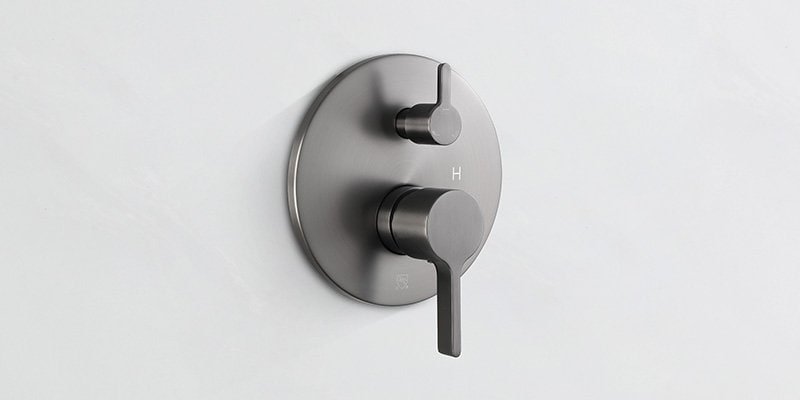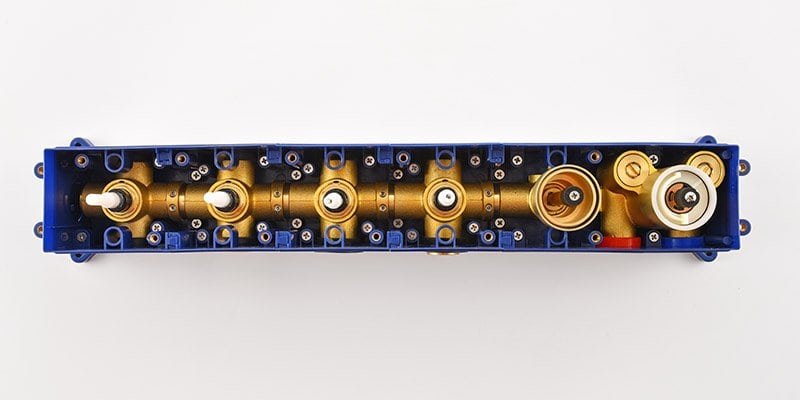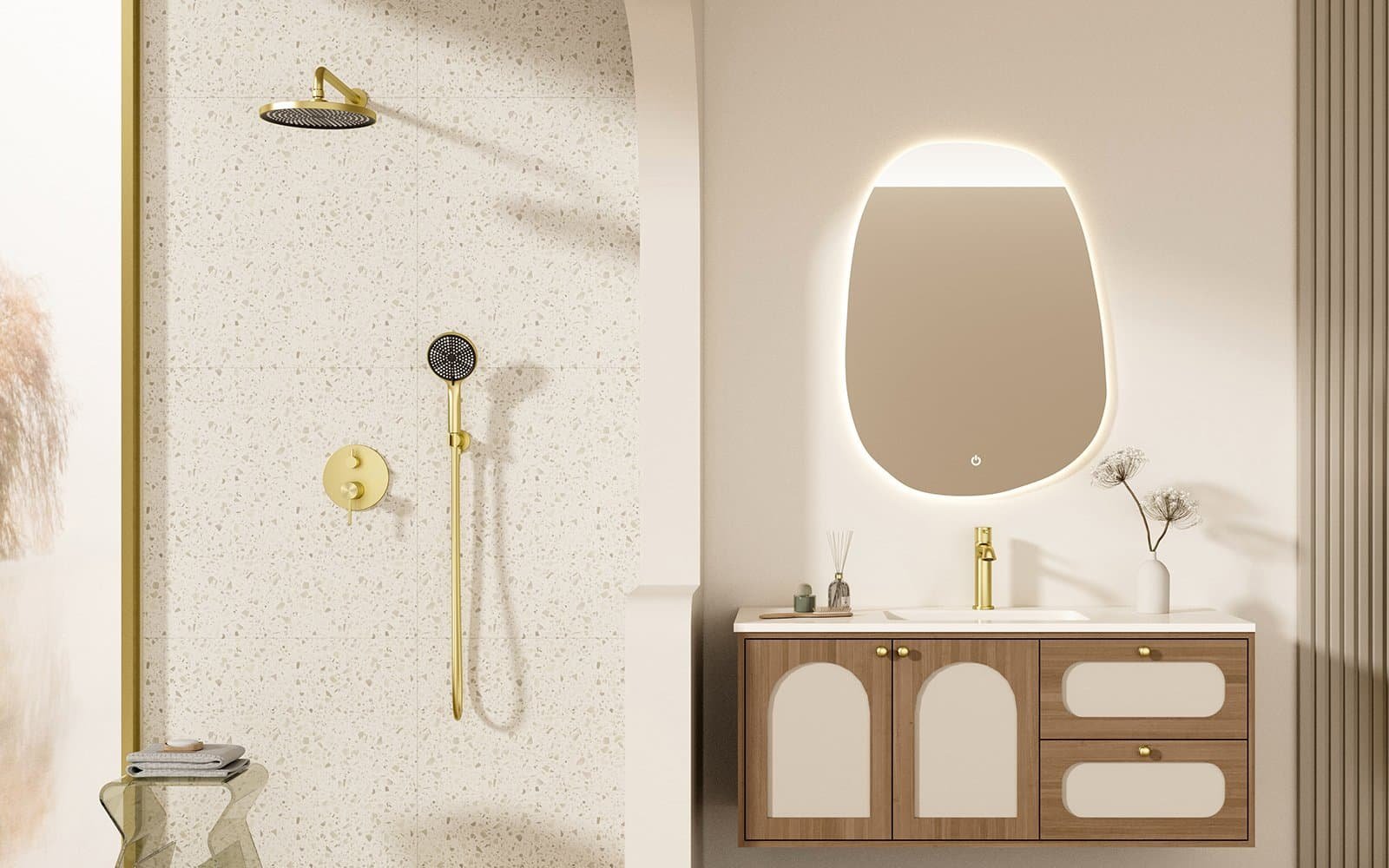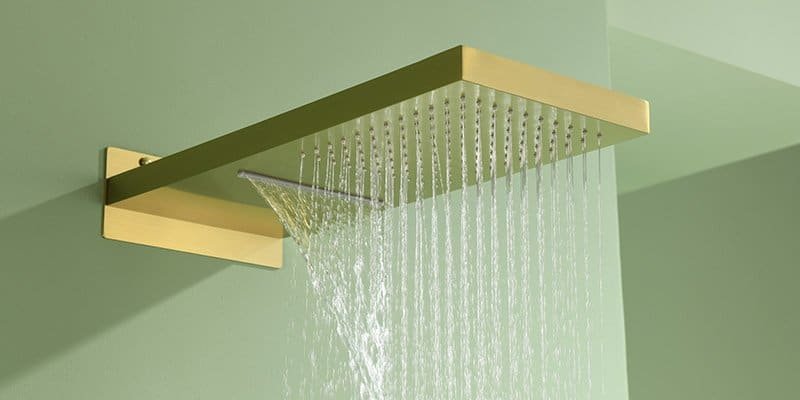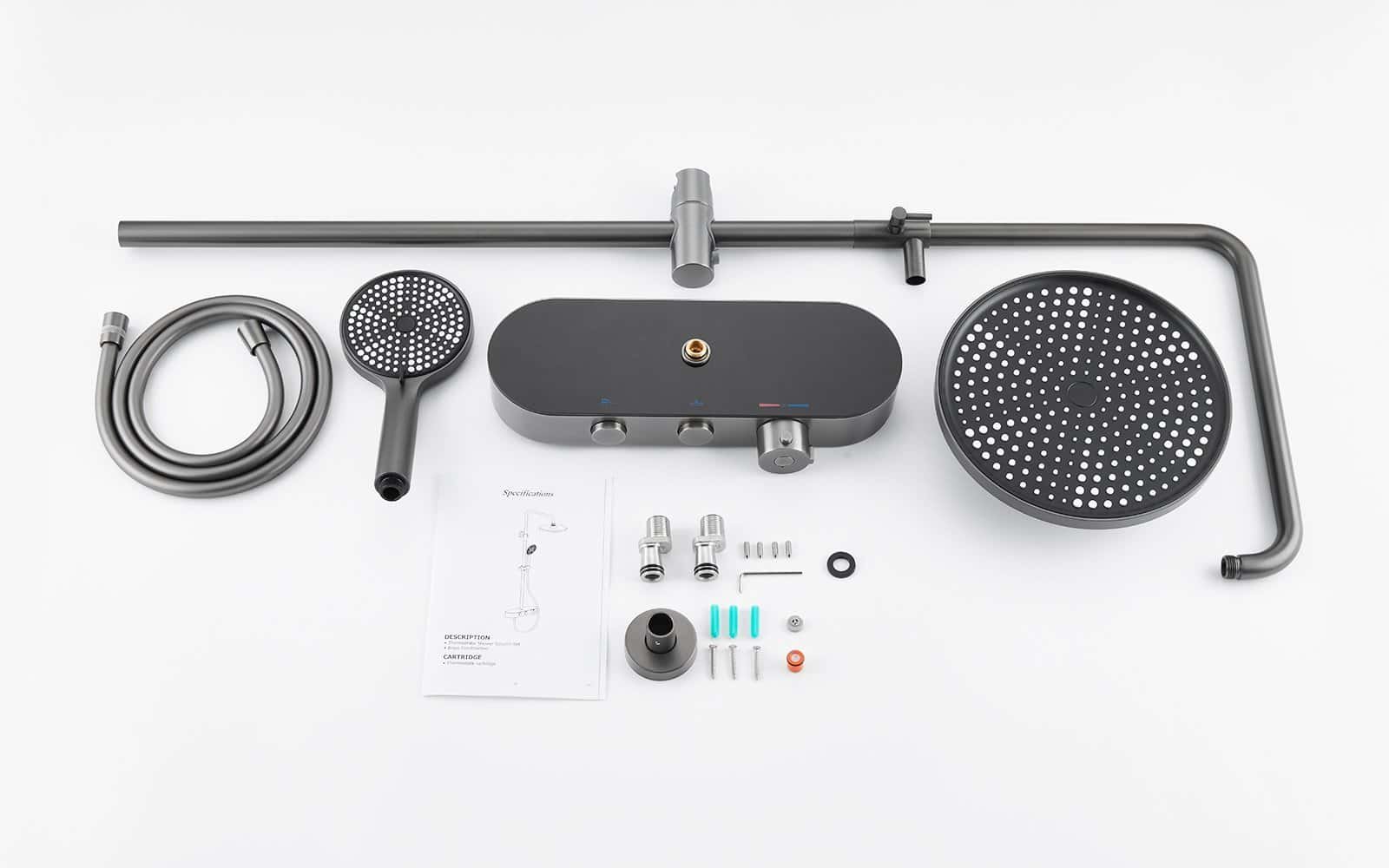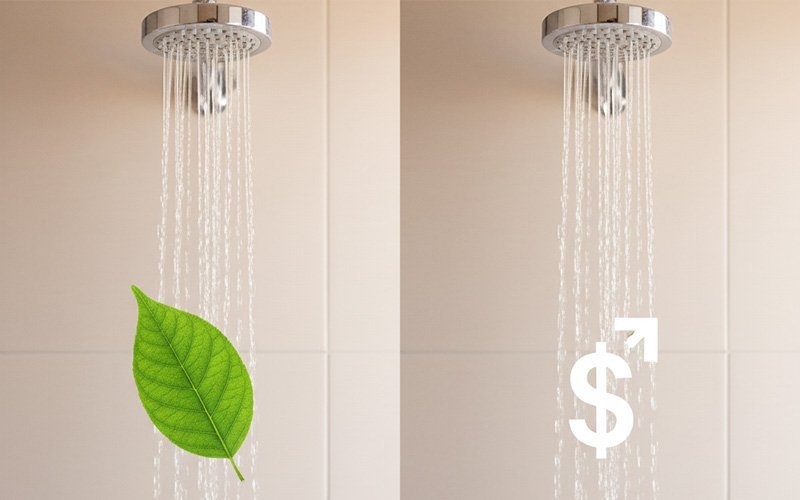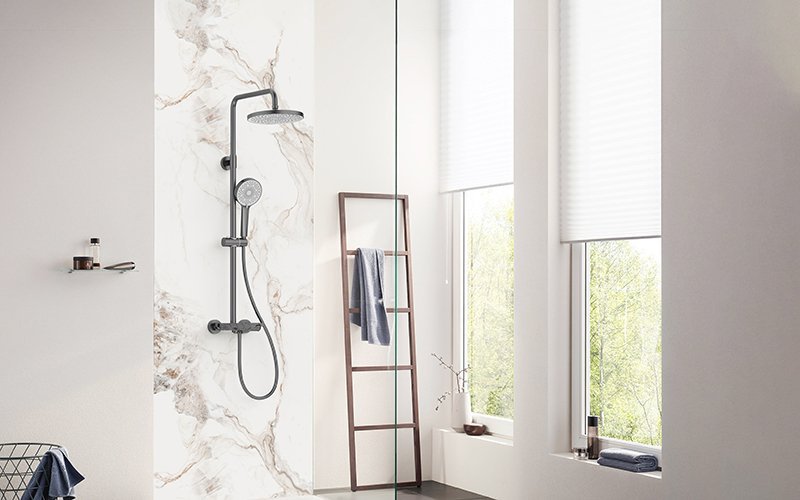Table of Content
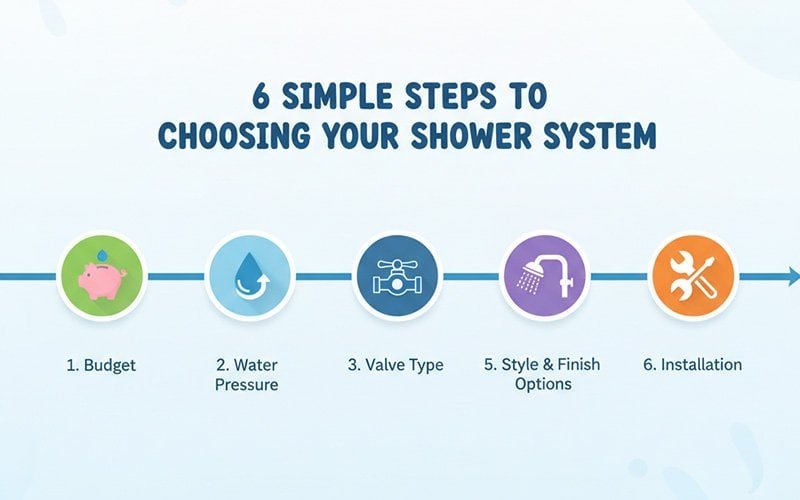
**Disclaimer:**
This guide is intended to provide general industry knowledge and information about shower systems. The functions, features, certifications, and price ranges discussed are for illustrative purposes only and do not represent or guarantee that any specific product sold by the Rosana brand will have all of the aforementioned features or meet the stated standards. Please refer to the description on the specific product page for details.
Picking a new shower system means thinking about how it works, how it looks, and how much it costs. Every part, from the pipes in the wall to the faucet you see, makes a difference.
With so many choices like valves, showerheads, and colors, it’s easy to feel lost. Many people pick a shower based only on its looks and can be unhappy with how it works later.
This guide will make the process easier. It breaks down how to choose a shower into simple steps. You will learn how to figure out what you need, check your home’s plumbing, and make smart choices.

Step 1: Think About Your Needs and Budget
Before you look at any shower parts, the first step is to know what you need and how much you want to spend. The right shower is one that fits the people who use it every day.
Who Will Use the Shower?
Think about who lives in your house:
- Family Members: If you have young kids, a handheld shower sprayer is very helpful for bath time.1 For older family members, safety is important. Look for features like valves that keep the water from getting too hot suddenly. A shower with a bench or a place to add grab bars is also a good idea.
- Your Shower Style: Do you want a quick shower in the morning or a long, relaxing one? If you want a quick shower, you might want a showerhead with strong pressure. If you want to relax, you might like a large “rainfall” showerhead or even jets that spray water from the walls.
- Why You’re Upgrading: Are you just changing an old showerhead or redoing the whole bathroom? A small update is an easy project you can do yourself. A big remodel means you can change the plumbing and get a whole new system.
Set a Budget
The total cost of a new shower includes the fixtures, materials like tile, and paying a professional to install it. The installation can be a big part of the cost, sometimes 40% to 60% of the total, especially if it’s a custom job.
You might see very cheap shower systems online. They can be tempting, but they can cause problems later. These systems often use parts that are not standard and are hard to find if something breaks.
If a small part inside the wall fails, you might have to hire a plumber to open the wall, replace the whole valve, and then have a tiler fix the wall. This can cost much more than you saved at the start.
Buying from a known brand often means you get a warranty and can find replacement parts for many years. Thinking about the total cost over time can help you make a good choice.
Here is a table to help you plan your budget. (for reference only)
| Tier | Cost Range | What’s Included | Common Materials | Good For |
|---|---|---|---|---|
| Basic | $1,000 – $5,000 | A standard valve and a single showerhead. | Ready-made acrylic or fiberglass shower kits. | Projects where the budget is the main concern. |
| Mid-Range | $5,000 – $12,000 | A better valve, two showerheads (like a fixed one and a handheld one), and a glass door. | Custom tile, like ceramic or porcelain. | Full bathroom remodels that balance style and function. |
| Luxury | $12,000 – $20,000+ | A system with separate controls for temperature and water flow, a rain shower, and body sprays. | High-end materials like natural stone (marble or granite). | Creating a shower with many features, like a spa. |
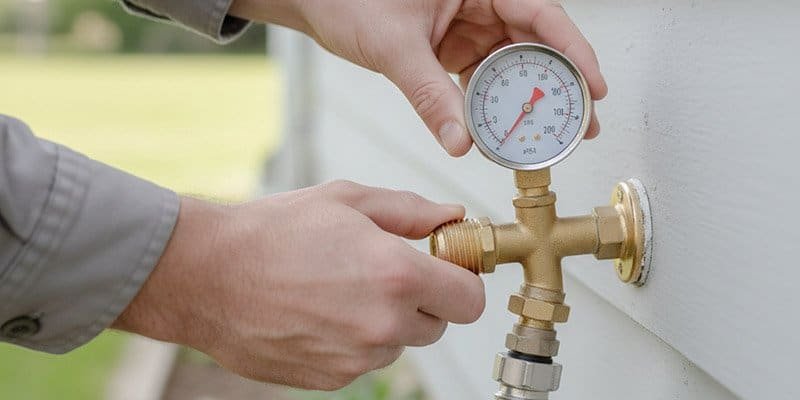
Step 2: Check Your Home’s Plumbing
Even the most expensive shower system won’t work well if your home’s plumbing can’t handle it. Before you buy anything, it’s important to check your plumbing. This helps you avoid the mistake of buying a shower that your home can’t support.
Water Pressure is Key
Water pressure is the force that pushes water through your pipes. It’s measured in pounds per square inch (PSI). Most shower systems work best with water pressure between 40 and 60 PSI.
If your home’s pressure is too low, a big rain showerhead might just trickle water. The age of your home or where it’s located can affect your water pressure.
How to Measure Your Water Pressure
You can easily test your home’s water pressure yourself.
- Get a Gauge: You can buy a water pressure gauge at a hardware store.
- Find a Spigot: The easiest place to test is an outdoor water spigot. Make sure all other faucets in your house are turned off.
- Attach and Test: Screw the gauge onto the spigot. Turn the water on all the way. The gauge will show you your home’s water pressure.16 This number will help you choose the right shower system.
Check Your Pipes and Walls
You also need to think about the pipes you have now.
- Pipe Size: Most homes in the U.S. have 1/2-inch pipes going to the shower. This is fine for most showers. But if you want a system with many sprays running at once, a plumber might suggest a larger 3/4-inch pipe to make sure there’s enough water flow.
- Wall Depth: The space inside your walls is also important. Most walls are made with 2×4 wood studs, which gives you about 3.5 inches of space. Some walls, called “plumbing walls,” are thicker and made with 2×6 studs, giving you about 5.5 inches of space. Some bigger, more complex shower valves need the extra space of a 2×6 wall to fit.
Knowing these details will help you and your plumber choose a system that will work well in your home.
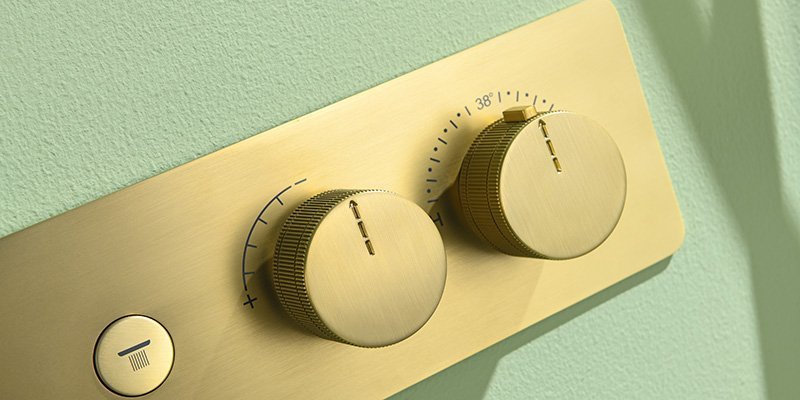
Step 3: Choose the Shower Valve
The shower valve is the engine of your shower. It’s hidden in the wall and mixes the hot and cold water. The type of valve you choose affects how your shower works and what kind of handles you can have.
What’s in a Valve?
A shower valve has two main parts:
- The Rough-In Valve: This is the brass part inside the wall that connects to the water pipes. It does all the work of mixing the water.
- The Trim Kit: This is everything you see on the outside of the wall, like the handle, the decorative plate, and the showerhead.
Two Main Types of Valves
There are two main types of shower valves.
- Pressure-Balanced Valves: This is the most common type. It keeps the water temperature steady by balancing the pressure of the hot and cold water. If someone flushes a toilet, the cold water pressure drops. The valve senses this and reduces the hot water flow to keep you from getting burned.5 These usually have one handle to control both temperature and flow.
- Thermostatic Valves: This type offers more precise control. It has a part inside that senses the actual water temperature and adjusts the hot and cold water to keep it exactly where you set it, usually within one degree.23 These systems often have two handles: one for temperature and one for water flow.25 This lets you set your favorite temperature and leave it there.
This table compares the two types.
| Feature | Pressure-Balanced Valve | Thermostatic Valve |
|---|---|---|
| How it Works | Balances the pressure of hot and cold water. | Controls the actual water temperature. |
| Temperature Control | Keeps temperature within a few degrees. | Keeps temperature very steady, within +/- 1 degree. |
| Safety | Helps prevent burns from pressure drops. | Helps prevent burns from both pressure and temperature changes. |
| How You Use It | One handle for both temperature and flow. | Separate handles for temperature and flow. You can “set it and forget it. |
| Using Multiple Sprays | Usually runs one thing at a time. | Can run multiple sprays at once with steady temperature. |
| Cost | Costs less. | Costs more, sometimes two to three times as much. |
| Installation | Simpler to install, fits in a standard 2×4 wall. | More complex, may need a deeper 2×6 wall. |
A Rule for Plumbing: Brands Must Match
A very important rule is that the valve inside the wall and the trim on the outside must be from the same brand.28 You cannot mix and match parts from different companies because they won’t fit together.
This means the brand you choose for the valve is a long-term decision. Some brands offer “universal” valves. This means you can install one type of valve in the wall, and it will work with many different styles of trim from that same brand.
If you install a universal valve, you can update the look of your shower later by just changing the trim on the outside. You won’t have to open up the wall again, which saves a lot of money and trouble.

Step 4: Pick Your Shower Parts
After you’ve decided on the valve, you can choose the parts that the water comes out of. These are the showerheads and sprayers that create the shower experience.
Choosing Your Showerhead
Different showerheads give you different feelings.
- Fixed Showerhead: This is the classic type that’s attached to the wall. They are simple and work well.
- Rainfall Showerhead: These are large heads that are mounted on the ceiling or a long arm so the water falls straight down on you. They give a gentle, all-over spray but need good water pressure to work well.
- Handheld Showerhead: This is a very useful option. It’s on a flexible hose, so you can move it around. It’s great for washing hair, cleaning the shower, or helping kids and pets.
- Dual System: This combines two types, like a fixed showerhead and a handheld one. A special valve lets you switch between them or use both at the same time.
- Body Sprays: These are small jets built into the shower walls that spray you from the side. They need a special valve system to work correctly.
Understanding Spray Patterns
Many showerheads let you choose different spray patterns.
- Wide Spray: This is the standard setting that gives you good coverage for rinsing.
- Targeted Jet: This makes the water stream stronger. It’s good for rinsing out thick hair.
- Pulsating Spray: This creates a pulsing feeling, which can be relaxing.
- Mist: This creates a fine, gentle mist.
- Air-Injection Spray: This mixes air with the water to make the drops feel bigger. It can make the shower feel stronger even if it’s using less water.
For Showers with Tubs
If you have a bathtub and shower combination, you’ll have a tub spout. If you’re replacing it, you need to know how it’s connected.
- How to Check: Look under the spout where it meets the wall. If you see a small screw, it’s a Slip-On spout. If there’s no screw, it’s a Threaded spout that twists off.
- The Diverter: The little knob on top of the spout is the diverter. When you pull it up, it sends the water up to the showerhead.
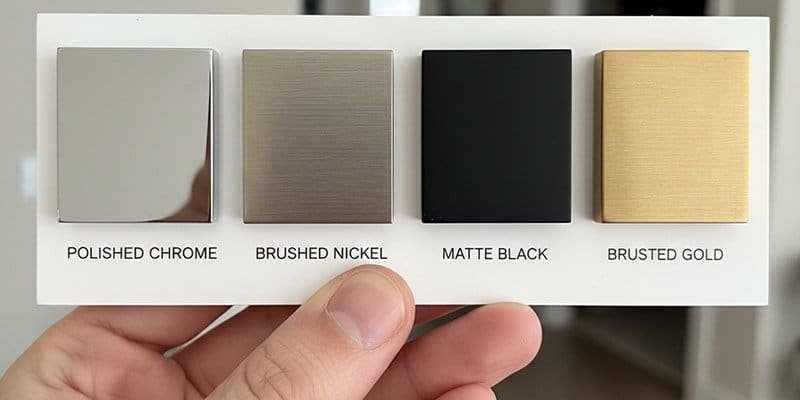
Step 5: Choose a Style and Finish
The style and finish are the parts of the shower you see the most. They help set the look of your bathroom. The finish also affects how long the fixture will last and how easy it is to clean.
Match Your Bathroom’s Look
The shape of your shower fixtures should match your bathroom’s style. A modern bathroom might have fixtures with straight lines and a matte black or chrome finish. A traditional bathroom might look better with curved fixtures in a bronze or nickel finish.
A Guide to Finishes
The finish is a protective coating on the fixture. High-quality finishes are more durable and less likely to peel or scratch.
This table compares popular finishes.
| Finish | Durability (1-5) | How Easy to Clean | Price | Good For |
|---|---|---|---|---|
| Polished Chrome | 5 | High | $ | A classic look that’s easy to match, but it shows every water spot and fingerprint. |
| Brushed Nickel | 5 | Low | $$ | Busy family bathrooms; its soft look hides water spots and fingerprints well. |
| Matte Black | 4 | Medium | $$$ | Modern bathrooms; it looks bold and hides fingerprints, but hard water spots can show up. |
| Brushed Gold / Brass | 3 | Medium | $$$$ | Bathrooms where you want a warm, elegant look. Can be more prone to scratching. |
| Oil-Rubbed Bronze | 4 | Low | $$$ | Traditional or rustic bathrooms; its dark color is great at hiding smudges. |
For Showers with Tubs
If you have a bathtub and shower combination, you’ll have a tub spout. If you’re replacing it, you need to know how it’s connected.
- How to Check: Look under the spout where it meets the wall. If you see a small screw, it’s a Slip-On spout. If there’s no screw, it’s a Threaded spout that twists off.
- The Diverter: The little knob on top of the spout is the diverter. When you pull it up, it sends the water up to the showerhead.
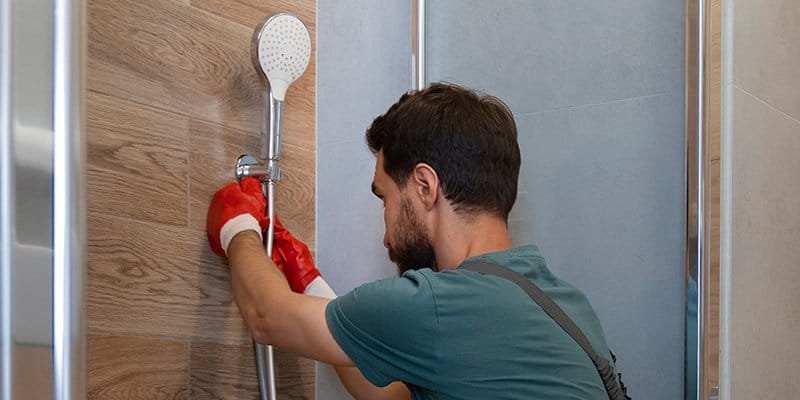
Step 6: Plan the Installation
The last step is to plan how the shower system will be installed. It’s important to know what you can do yourself and when you need to hire a professional.
DIY vs. Hiring a Pro
- DIY Tasks: Some jobs are easy for homeowners. Replacing a showerhead or a tub spout is usually simple and can be done with basic tools. This can save you money.
- Tasks for a Plumber: Any work that happens inside the wall should be done by a licensed plumber. This includes installing a new shower valve or moving pipes. This work requires special skills to prevent leaks, which can cause a lot of damage.
Cost of Professional Installation
Hiring a professional can cost from around $400 for a simple valve replacement to over $2,000 for a big project. A project that involves moving pipes and custom tile work will cost more because it takes more time and skill.
Plan for the Future
If you are remodeling and the walls are open, it’s a great time to plan for the future. You can have your contractor install a piece of wood (called blocking) between the wall studs where you might want to add a grab bar later.
This costs very little to do during a remodel and makes it much easier and safer to install grab bars in the future.

Frequently Asked Questions (FAQs)
Related Posts





